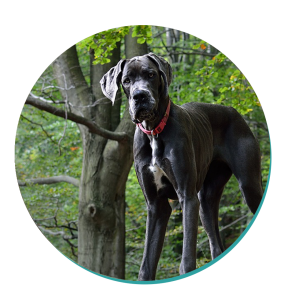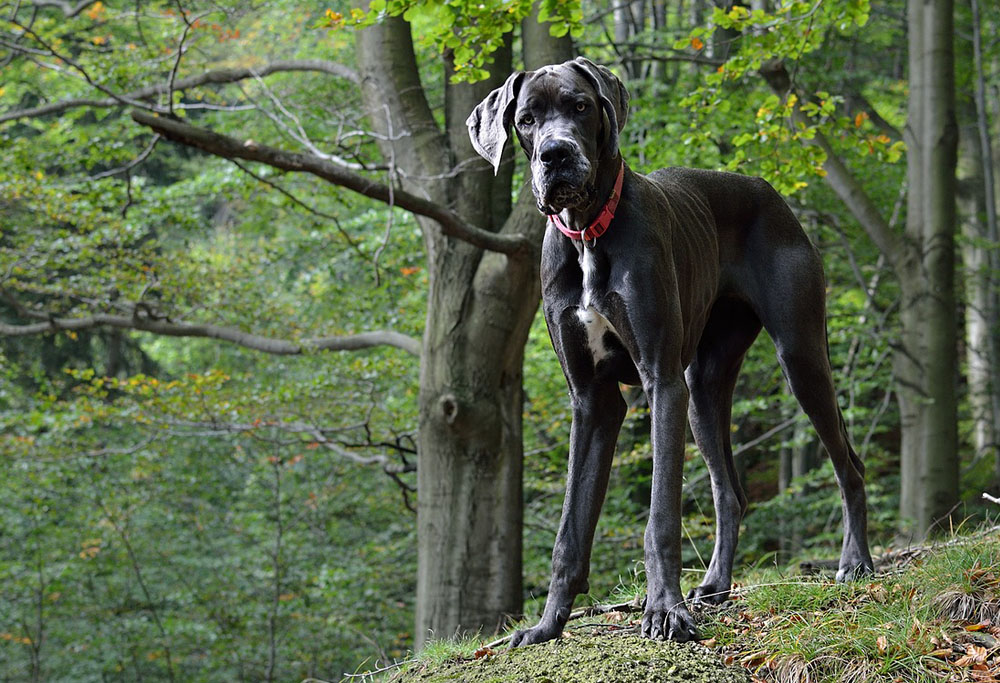These gentle giants turn heads wherever they go. The Great Dane takes centre stage in this Dog Breed Corner!
 Quick Facts ✔
Quick Facts ✔
Height – 70 – 76cm
Weight – 45 – 65kg, 65 – 80kg
Lifespan – 7 – 10 years
Country of origin – Germany
Breed type – Working Dog
- Big families or households with other pets
- Dog-proof homes
- Owners willing to train their Great Dane
Great Dane Breed History ♜
It’s not entirely clear where the Great Dane came from, but most agree that this breed isn’t from Denmark. Instead, there’s a longer record of Great Danes – originally called Boar Hounds – in Germany, where they were used to hunt boar and other large prey. In fact, the cropping of the ears was intended to cut down the risk of injuries during hunts.
It’s easy to see that the Great Dane is the offspring of similar large breeds like Mastiffs and Irish Wolfhounds, which account for their large stature (from the Mastiff) and slender body (from the Wolfhounds).
Eventually, all of the aggression was bred out of this massive breed. After this, Owners began to bring these gentle giants into their homes. Even without the hunting drive, these dogs still make excellent watch dogs simply because of their intimidating demeanour.
Personality, Traits, & Trainability ★
Despite their “tough guy” look, the Great Dane is a big, cuddly lap dog. They get along well with children and all kinds of other doggos, and they’re happiest when they have the chance to curl up on the couch for a snooze.
While Great Danes are playful, and a bit goofy, they’re not necessarily the athletic type. You’ll need to give them daily walks to stretch their legs, but don’t expect them to want long runs. In fact, their risk for bloat makes heavy exercise dangerous, but more on that later.
Training with the Great Dane is generally easy, which is a huge plus – this breed is so large that training needs to be a priority. As gentle and kind as this breed is, without proper politeness training, they’re likely try to jump up on new friends and try to sneak a few bites off the dinner table.
Great Dane Health, Grooming, and Living Conditions ⌂
These big couch potatoes don’t need a whole lot in terms of their living conditions. That said, your life will be a lot easier if you give them enough space to move around comfortably. An excited Great Dane can be a bit of a bulldozer, after all.
Having a backyard is, of course, always a plus. But unless your yard is large enough for a few long laps, you’ll still want to get your gentle giants out of the house to stroll the block or go to the dog park.
Now, as wonderful as it is to own a Great Dane, it’s important to acknowledge their short lifespans. According to PetHelfpul, only 17% of Great Danes make it past 10 years old. Some of this may be due to genetic problems common in large breed dogs, such as hip dysplasia, cardiomyopathy, and thyroid issues.
Another huge risk for Great Danes is bloat, a condition in which gas accumulation in the digestive system creates a life-threatening situation. Unfortunately, there’s no sure-fire way to prevent bloat in deep-chested dogs like the Great Dane. However, one suggestion that does seem to lower the risk includes feeding your doggo several smaller meals throughout the day instead of two large ones.
Fun Fact about the Great Dane ♥
Great Danes grow amazingly fast. At 6 weeks, you bring home a little bundle of puppy that weighs about 4kg. Within 12 months, you’ve got a dog that can tower over you on their hind legs! It seems like every time you blink, your Great Dane puppy has grown a couple of centimetres – at least!
Do you need a big dog expert in Adelaide, Darwin, Hobart, or anyone else to mind your Great Dane? Find a trusted Mad Paws Pet Sitter near you!

